 |
 |
 |
 |
 |
 |
| |
 |
|
 |
 |
 |
  |
  |
 |
 |
 |
 |
|
|
 |
|
 |
 |
 |
BUILDING |
 |
|
 |
|
 |
 |
 |
| |
 |
| 
 |
Serpentine Gallery Pavilion
|
|
 |
 |
 |
 |
DESIGNER |
 |
|
|
 |
|
 |
 |
 |
| |
 |
|
 |
 |
 |
 |
DESCRIPTION |
 |
|
|
 |
|
 |
 |
 |
|
|
 |
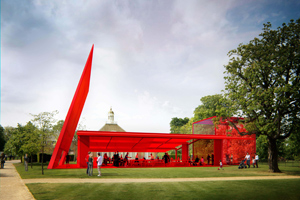 In 2010 the Serpentine Gallery celebrates its 40th anniversary. This year the Serpentine Gallery Pavilion is designed by world-renowned French architect Jean Nouvel. This is the 10th commission in the Gallery’s annual architectural series, the world’s first and most ambitious programme of its kind. It will be the architect’s first completed building in the UK. In 2010 the Serpentine Gallery celebrates its 40th anniversary. This year the Serpentine Gallery Pavilion is designed by world-renowned French architect Jean Nouvel. This is the 10th commission in the Gallery’s annual architectural series, the world’s first and most ambitious programme of its kind. It will be the architect’s first completed building in the UK.
The Pavilion commission has become an international site for architectural experimentation and follows a long tradition of Pavilions by some of the world’s greatest architects. The immediacy of the commission – a maximum of six months from invitation to completion – provides a unique model worldwide.
The design for the 2010 Pavilion is a contrast of lightweight materials and dramatic metal cantilevered structures. The entire design is rendered in a vivid red that, in a play of opposites, contrasts with the green of its park setting. The colour reflects the iconic British images of traditional telephone boxes, post boxes and London buses.
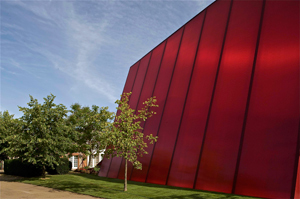 The building consists of bold geometric forms, large retractable awnings and a freestanding wall that climbs 12m above the lawn, sloping at a gravity defying angle. Striking glass, polycarbonate and fabric structures create a versatile system of interior and exterior spaces. The building consists of bold geometric forms, large retractable awnings and a freestanding wall that climbs 12m above the lawn, sloping at a gravity defying angle. Striking glass, polycarbonate and fabric structures create a versatile system of interior and exterior spaces.
Around the Pavilion, Nouvel has created spaces for outdoor enjoyment and play, bringing the tradition of French civic parks to London. Red table tennis tables, draughts, chess, frisbees and kites will be available for the public to play with throughout the summer months.
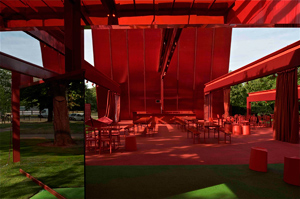 The flexible auditorium will accommodate the Serpentine Gallery café and the Gallery’s Park Nights programme which culminates in the 5th Serpentine Gallery Marathon: The Marathon of Maps for the 21 Century on 16 and 17 October. Maps have a powerful hold on our imaginations, defining our understanding of geography, scale, space and ideas. Artists, writers, thinkers and scientists will present maps encompassing their experience of the world today. The flexible auditorium will accommodate the Serpentine Gallery café and the Gallery’s Park Nights programme which culminates in the 5th Serpentine Gallery Marathon: The Marathon of Maps for the 21 Century on 16 and 17 October. Maps have a powerful hold on our imaginations, defining our understanding of geography, scale, space and ideas. Artists, writers, thinkers and scientists will present maps encompassing their experience of the world today.
Jean Nouvel is responsible for the design of over 200 buildings the world over, including the Copenhagen Concert Hall (2009); the Ferrari Factory, Modena (2009); Pavilion B at the Genoa Trade Fair (2009); 40 Mercer Street, New York (2008); the Musée du quai Branly, Paris (2006); the extension to the Museo Nacional Centro de Arte Reina Sofía, Madrid (2006); the Guthrie Theater, Minneapolis (2001); the Torre Agbar, Barcelona (2000); the Culture and Congress Centre, Lucerne (2000), and the Institut du Monde Arabe, Paris (1989).
Nouvel’s body of work is unparalleled in its innovation and range. His approach is characterised by a conceptual rigour, rather than by an overarching aesthetic. He emphasises research, analysis and discussion, creating designs that are highly individual to each project. A key part of Nouvel’s process is his embrace of other disciplines, including music, literature and the moving image.
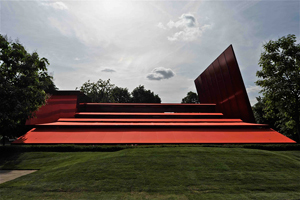 Jean Nouvel has worked with the structural design and engineering firm Arup, led by David Glover and Ed Clark with Cecil Balmond, to realise this project. Jean Nouvel has worked with the structural design and engineering firm Arup, led by David Glover and Ed Clark with Cecil Balmond, to realise this project.
Julia Peyton-Jones, Director, and Hans Ulrich Obrist, Co-Director, Serpentine Gallery, said: ‘We could not be more thrilled that Jean Nouvel has designed the 10th Serpentine Gallery Pavilion, the only commission of its kind worldwide that annually invites pre-eminent architects to complete their first built structure in England. It is an honour to bring Nouvel’s globally acclaimed work to London for everyone to enjoy.’
There is no budget for the Serpentine Gallery Pavilion commission. It is paid for by sponsorship, sponsorship help-in-kind and the sale of the finished structure, which does not cover more than 40% of its cost. The Serpentine Gallery collaborates with a range of companies and individuals whose support makes it possible to realise the Pavilion. On the occasion of the 10th anniversary we are delighted the Pavilion is being supported by Arts Council England, through its Sustain programme.
Moira Sinclair, Executive Director of Arts Council England, London said: 'Our Sustain fund was established to help support artistic excellence in the context of the economic downturn, and the Serpentine Pavilion is a landmark example – uniquely special to and beloved by London, and a key 'moment' on the international visual arts and architectural calendars. I am delighted that this grant, alongside our core funding to the Gallery, will help ensure a stunning Pavilion for 2010 that will inspire, intrigue and entertain everyone who explores it.'
Arup will provide all the engineering and specialist design solutions for the Pavilion. Arup Director David Glover commented: ‘It is a privilege to support the Pavilion programme again this year on its 10th anniversary. Arup’s commitment to the Serpentine Pavilion reflects our belief in the project and the positive experience our teams get from working with some of the most exciting architects of our time. Ateliers Jean Nouvel are renowned for taking a rigorous and contextual approach to design which brings delight and surprise to all their projects. This year’s Pavilion is sure to be no exception.’
Peter Rogers, Director of Stanhope, will donate his expertise to all aspects of the Pavilion. He said: ‘The Serpentine Pavilion is a unique project whose innovative and challenging designs transcend normal building projects as well as fusing art and architecture in an exciting built form.’ |
|
 |
 |
 |
|
 |
|
| Serpentine Gallery Pavilion Commission |
 |
|
 |
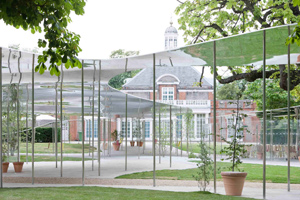 The Serpentine Gallery Pavilion commission was conceived by Serpentine Gallery Director, Julia Peyton-Jones, in 2000. It is an ongoing programme of temporary structures by internationally acclaimed architects and designers. The series is unique worldwide and presents the work of an international architect or design team who has not completed a building in England at the time of the Gallery’s invitation. The Pavilion architects to date are: Kazuyo Sejima and Ryue Nishizawa, SANAA, 2009; Frank Gehry, 2008; Olafur Eliasson and Kjetil Thorsen, 2007; Rem Koolhaas and Cecil Balmond, with Arup, 2006; Álvaro Siza and Eduardo Souto de Moura with Cecil Balmond, Arup, 2005; MVRDV with Arup, 2004 (un-realised); Oscar Niemeyer, 2003; Toyo Ito with Arup, 2002; Daniel Libeskind with Arup, 2001; and Zaha Hadid, 2000. Each Pavilion is sited on the Gallery’s lawn for three months and the immediacy of the process – a maximum of six months from invitation to completion – provides a peerless model for commissioning architecture. The Serpentine Gallery Pavilion commission was conceived by Serpentine Gallery Director, Julia Peyton-Jones, in 2000. It is an ongoing programme of temporary structures by internationally acclaimed architects and designers. The series is unique worldwide and presents the work of an international architect or design team who has not completed a building in England at the time of the Gallery’s invitation. The Pavilion architects to date are: Kazuyo Sejima and Ryue Nishizawa, SANAA, 2009; Frank Gehry, 2008; Olafur Eliasson and Kjetil Thorsen, 2007; Rem Koolhaas and Cecil Balmond, with Arup, 2006; Álvaro Siza and Eduardo Souto de Moura with Cecil Balmond, Arup, 2005; MVRDV with Arup, 2004 (un-realised); Oscar Niemeyer, 2003; Toyo Ito with Arup, 2002; Daniel Libeskind with Arup, 2001; and Zaha Hadid, 2000. Each Pavilion is sited on the Gallery’s lawn for three months and the immediacy of the process – a maximum of six months from invitation to completion – provides a peerless model for commissioning architecture.
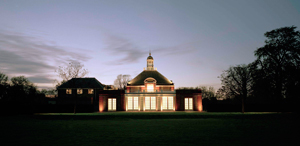 Park Nights, the Gallery’s acclaimed programme of public talks and events, will take place in Nouvel’s Pavilion, and will culminate in the annual Serpentine Gallery Marathon that takes place in October. 2010 is the 5th anniversary of the Marathon programme. In 2006 the Park Nights programme included the renowned 24-hour Serpentine Gallery Interview Marathon, convened by Hans Ulrich Obrist and architect Rem Koolhaas and was followed, in 2007, by the Serpentine Gallery Experiment Marathon presented by artist Olafur Eliasson and Obrist, which featured experiments performed by leading artists and scientists. In 2008, Obrist led over 60 participants in the Serpentine Gallery Manifesto Marathon, and 2009 saw the Serpentine Gallery Poetry Marathon. Park Nights, the Gallery’s acclaimed programme of public talks and events, will take place in Nouvel’s Pavilion, and will culminate in the annual Serpentine Gallery Marathon that takes place in October. 2010 is the 5th anniversary of the Marathon programme. In 2006 the Park Nights programme included the renowned 24-hour Serpentine Gallery Interview Marathon, convened by Hans Ulrich Obrist and architect Rem Koolhaas and was followed, in 2007, by the Serpentine Gallery Experiment Marathon presented by artist Olafur Eliasson and Obrist, which featured experiments performed by leading artists and scientists. In 2008, Obrist led over 60 participants in the Serpentine Gallery Manifesto Marathon, and 2009 saw the Serpentine Gallery Poetry Marathon. |
|
 |
 |
 |
|
 |
|
| Serpentine Galleries Pavilion History |
 |
|
 |
|
 |
 |
 |
|
 |
|
|
|
 |
|
 |
 |
 |
 |
 |
 |
 |
VIDEO |
 |
|
|
 |
|
 |
 |
 |
| |
 |
|
 |
 |
 |
 |
LOCATION |
 |
|
|
 |
|
 |
 |
 |

|
 |

|

|
 |

|
|
|
 |
|
Website |
|
 |
|
 |
 |
 |
 |
MAP |
 |
|
|
 |
|
 |
 |
 |
| |
 |
|
 |
 |
 |
 |
|
TYPOLOGY |
 |
|
|
 |
|
 |
 |
 |
|
|
 |
ARCHITECTURE | Commercial buildings
Bars, cafeterias
Urban equipment and structures for public areas
Structures for public areas
Other architectural structures
Pavilions, kiosks, facilities
| |
 |
 |
 |
 |
CHRONOLOGY |
 |
|
|
 |
|
 |
 |
 |
Project |
 |
|
 |
| 
 |
2010
|
|
Realisation |
 |
|
 |
| 
 |
2010 - 2010 |
|
 |
 |
 |
 |
BIBILIOGRAPHIC REFERENCES |
 |
|
|
 |
|
 |
 |
 |
|
 |
| "Jean Nouvel. 2010", Serpentine Gallery Pavilions. Visions of new architecture. 2000-2013, supplement A+U. Architecture and Urbanisme 9/2013, september 2013, pp. 60-63 |
|
|
| Peter Buchanan, "Tectónica del espectáculo. Los pabellones de la Serpentine / Tectonics of Spectacle. The Serpentine Pavilions", Arquitectura Viva 141, 3/2011 [Espacios efímeros / Ephemeral Spaces], pp. 28-41 |
|
|
| Asad Syrkett, "Snapshot: Serpentine Gallery Pavilion 2010. Ateliers Jean Nouvel", Architectural Record 9/2010, september 2010, p. 176 |
|
|
| "Serpentine Gallery Pavilion 2010, London, UK. Jean Nouvel", A+U. Architecture and Urbanism 9/2010, september 2010, pp. 122-127 |
|
|
| Will Hunter, "Seeing rouge: Nouvel's Serpentine Pavilion is brightly coloured but dully conceived", Architectural Review 1362, august 2010, p. 23 |
|
 |
 |
 |
 |
 |
 |
 |
CLIENT |
 |
|
|
 |
|
 |
 |
 |
| |
 |
|
 |
 |
 |
 |
STRUCTURES |
 |
|
|
 |
|
 |
 |
 |
| |
 |
|
 |
 |
 |
 |
LANDSCAPE DESIGN |
 |
|
|
 |
|
 |
 |
 |
| |
 |
|
 |
 |
 |
 |
STAFF |
 |
|
|
 |
|
 |
 |
 |
|
 |
|
Associate architect |
 |
|
Project management |
 |
|
Design team |
 |
| Driss Benabdallah, Sophie Laromiguiere |
|
Plastic models, rendering, visualization |
 |
| Raphael Renard, Vatsana Takham |
|
Structural consultant |
 |
Arup
Cecil Balmond, David Glover, Ed Clark, Ben Moss, Paul Nuttall, Felix Weber, Graham Hennessy, Jeff Shaw, Charlotte Roben, Jack Wilshaw, Wojciech Cepok |
|
Art direction |
 |
Julia Peyton-Jones
with Hans Ulrich Obrist, Serpentine Gallery |
|
Project leader |
 |
| Julie Burnell, Serpentine Gallery |
|
Construction management |
 |
MACE
Stephen Pycroft, Gareth Lewis, Ian Eggers, Phil Solomon, Benn Chandler, Tony Blackledge, Vishal Mehta, Gurmeet Virdee, Robert Vine |
|
 |
 |
 |
 |
ANNOTATIONS |
 |
|
|
 |
|
 |
 |
 |
| |
 |
|
 |
  |
 |
|
|